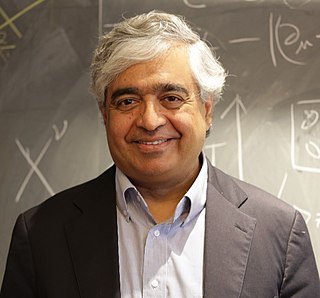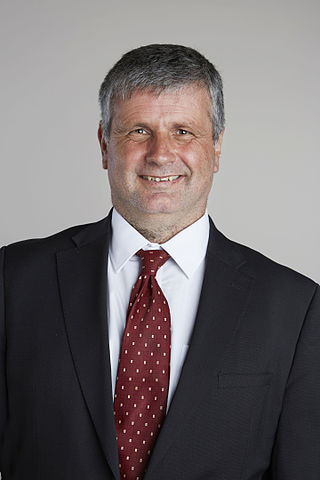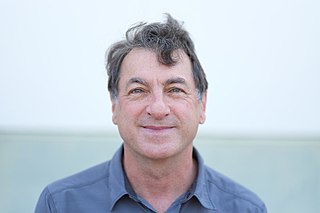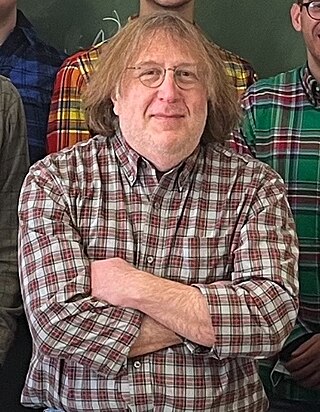Related Research Articles

Condensed matter physics is the field of physics that deals with the macroscopic and microscopic physical properties of matter, especially the solid and liquid phases, that arise from electromagnetic forces between atoms and electrons. More generally, the subject deals with condensed phases of matter: systems of many constituents with strong interactions among them. More exotic condensed phases include the superconducting phase exhibited by certain materials at extremely low cryogenic temperatures, the ferromagnetic and antiferromagnetic phases of spins on crystal lattices of atoms, the Bose–Einstein condensates found in ultracold atomic systems, and liquid crystals. Condensed matter physicists seek to understand the behavior of these phases by experiments to measure various material properties, and by applying the physical laws of quantum mechanics, electromagnetism, statistical mechanics, and other physics theories to develop mathematical models and predict the properties of extremely large groups of atoms.

Philip Warren Anderson was an American theoretical physicist and Nobel laureate. Anderson made contributions to the theories of localization, antiferromagnetism, symmetry breaking, and high-temperature superconductivity, and to the philosophy of science through his writings on emergent phenomena. Anderson is also responsible for naming the field of physics that is now known as condensed matter physics.

Alexander van Oudenaarden is a Dutch biophysicist and systems biologist. He is a leading researcher in stem cell biology, specialising in single cell techniques. In 2012 he started as director of the Hubrecht Institute and was awarded three times an ERC Advanced Grant, in 2012, 2017, and 2022. He was awarded the Spinoza Prize in 2017.

Subir Sachdev is Herchel Smith Professor of Physics at Harvard University specializing in condensed matter. He was elected to the U.S. National Academy of Sciences in 2014, received the Lars Onsager Prize from the American Physical Society and the Dirac Medal from the ICTP in 2018, and was elected Foreign Member of the Royal Society ForMemRS in 2023. He was a co-editor of the Annual Review of Condensed Matter Physics 2017–2019, and is Editor-in-Chief of Reports on Progress in Physics 2022-.
Spinons are one of three quasiparticles, along with holons and orbitons, that electrons in solids are able to split into during the process of spin–charge separation, when extremely tightly confined at temperatures close to absolute zero. The electron can always be theoretically considered as a bound state of the three, with the spinon carrying the spin of the electron, the orbiton carrying the orbital location and the holon carrying the charge, but in certain conditions they can behave as independent quasiparticles.
Bernd Büchner is, since 2003, Director of the Institute for Solid State Research, IFW Dresden and Professor for Experimental Physics at the Dresden University of Technology. Büchner is known for contributions to the field of high-temperature superconductivity, recent work on iron-based superconductors and authored over 1000 scientific papers.

Piers Coleman is a British-born theoretical physicist, working in the field of theoretical condensed matter physics. Coleman is professor of physics at Rutgers University in New Jersey and at Royal Holloway, University of London.
Bismuth selenide is a gray compound of bismuth and selenium also known as bismuth(III) selenide.
Roderich Moessner is a theoretical physicist at the Max Planck Institute for the Physics of Complex Systems in Dresden, Germany. His research interests are in condensed matter and materials physics, especially concerning new and topological forms of order, as well as the study of classical and quantum many-body dynamics in and out of equilibrium.
Orbitons are one of three quasiparticles, along with holons and spinons, that electrons in solids are able to split into during the process of spin–charge separation, when extremely tightly confined at temperatures close to absolute zero. The electron can always be theoretically considered as a bound state of the three, with the spinon carrying the spin of the electron, the orbiton carrying the orbital location and the holon carrying the charge, but in certain conditions they can become deconfined and behave as independent particles.

Sharon C. Glotzer is an American scientist and "digital alchemist", the Anthony C. Lembke Department Chair of Chemical Engineering, the John Werner Cahn Distinguished University Professor of Engineering and the Stuart W. Churchill Collegiate Professor of Chemical Engineering at the University of Michigan, where she is also professor of materials science and engineering, professor of physics, professor of macromolecular science and engineering, and professor of applied physics. She is recognized for her contributions to the fields of soft matter and computational science, most notably on problems in assembly science and engineering, nanoscience, and the glass transition, for which the elucidation of the nature of dynamical heterogeneity in glassy liquids is of particular significance. She is a member of the National Academy of Sciences, the National Academy of Engineering, and the American Academy of Arts and Sciences.
Bernhard Keimer is a German physicist and Director at the Max Planck Institute for Solid State Research. His research group uses spectroscopic methods to explore quantum many-body phenomena in correlated-electron materials and metal-oxide heterostructures.

Andrew Peter Mackenzie is a director of Physics of Quantum Materials at the Max Planck Institute for Chemical Physics of Solids in Dresden, Germany and Professor of Condensed Matter Physics at the University of St Andrews, Scotland. He became a co-editor of the Annual Review of Condensed Matter Physics as of 2020.
Andrea Jo-Wei Liu is the Hepburn Professor of Physics at the University of Pennsylvania, where she holds a joint appointment in the Department of Chemistry. She is a theoretical physicist studying condensed matter physics and biophysics. She is particularly known for her study of jamming, a phenomenon in which disordered materials become rigid with increasing density and stress. She is a Simons Investigator and Simons Fellow in Theoretical Physics, fellow of the American Physical Society (APS), the American Association for the Advancement of Science (AAAS), the American Academy of Arts and Sciences, and a member of the National Academy of Sciences (NAS).

Sergej Flach is a theoretical physicist whose research has spanned a number of scientific fields in his career. With about 240 publications to his name, his research has been cited over 16,000 times giving him an h-index of 58 and i10-index of 174. He is a member of the American Physical Society, German Physical Society, Korean Physical Society, and New Zealand Institute of Physics. He is an editorial board member of Chaos (2016-) and was an editorial board member of Physical Review E (2009–2011).
Claudia Draxl is a physicist. She is a full professor at the Humboldt University of Berlin in theoretical condensed-matter physics.
Pablo Jarillo-Herrero is a Spanish physicist and current Cecil and Ida Green Professor of Physics at Massachusetts Institute of Technology (MIT).

Mark John Bowick is a theoretical physicist in condensed matter theory and high energy physics. He is the deputy director of the Kavli Institute for Theoretical Physics at the University of California, Santa Barbara, and a Visiting Distinguished Professor of Physics in UCSB's Physics Department.

Randall David Kamien is a theoretical condensed matter physicist specializing in the physics of liquid crystals and is the Vicki and William Abrams Professor in the Natural Sciences at the University of Pennsylvania.
References
- ↑ J. van den Brink and D. Khomskii (1999). "Double-exchange via degenerate orbitals". Physical Review Letters . 82 (5): 1016. arXiv: cond-mat/9810394 . Bibcode:1999PhRvL..82.1016V. doi:10.1103/PhysRevLett.82.1016. S2CID 55977506.
- ↑ J. van den Brink (2006). "Transition Metal Oxides: Travels in one dimension". Nature Materials . 5 (6): 427–8. Bibcode:2006NatMa...5..427V. doi:10.1038/nmat1648. PMID 16738674. S2CID 195293149.
- ↑ D.V. Efremov, J. van den Brink and D.I. Khomskii (2004). "Bond- versus site-centred ordering and possible ferroelectricity in manganites". Nature Materials . 3 (12): 853–6. Bibcode:2004NatMa...3..853E. doi:10.1038/nmat1236. PMID 15558036. S2CID 19521760.